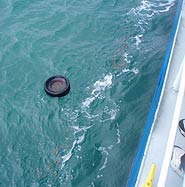Climate for Action: Spring Cleaning
Tuesday, March 31st, 2009About the Author: Loreal Crumbley, a senior at George Mason University, is an intern with EPA’s Environmental Education Division through EPA’s Student Temporary Employment Program (STEP).
For many of you, spring cleaning is just around the corner. I don’t know about you but my family has already begun cleaning our home. Washing windows, dusting, cleaning pipes, washing and packing away winter necessities are just a few things families do when cleaning.
We all use household cleaners, solvents and detergents. Most household shelves are filled with toxic substances. Ordinary household cleaners and solvents contain materials that can pollute our air and water systems. These materials contain acids, volatile organic compounds (VOC), lye, and other toxic chemicals. The release of these toxic chemicals into our environment can cause air pollution, as well as soil and groundwater damage. Contaminating our air and water can threaten human health and other organisms living in our environment.
We can limit the amount of toxic chemicals that are released into our environment by changing how we clean our homes. To begin non-toxic cleaning, you should use natural methods to clean your home. Some examples are:
- Baking soda is frequently used to reduce the effects of odors in water and in the air. Many use baking soda to freshen-up carpets and as air fresheners. It can also be used when cleaning kitchens, bathrooms and windows.
- Vinegar and lemon juice can be used to clean scum and grime off of dishes. They are also good when cleaning copper or brass objects. Vinegar can be used when cleaning bathrooms, kitchens, floors and appliances.
- Bar soaps can be used in the place of bleaches, ammonias, and detergents. When doing laundry these detergents can be harmful to our environment and sometimes cause allergies and skin irritation. Bars soaps are less toxic and can reduce allergies and skin irritation.
- Hang drying your clothes can be an alternative to using a dryer. Chemically loaded fabric softeners are sometimes used in dryers; hang drying can eliminate this as well as reducing the amount of energy you use in your home.
These are just a few tips to non-toxic cleaning around the home. I’m sure lots of you have your own special home recipes that you use. Please let me know; we all need to reduce the amount of toxics that we release into the environment.
Remember it is our job to keep our environment healthy and beautiful!! Keeping our environment clean and safe will protect the earth and our health!



 Recently my dad and stepmom came to visit me and told me about the new house they bought. My dad told me about what they are doing to the house to get ready for moving in – painting, new appliances, and some remodeling. I asked my dad if he had bought
Recently my dad and stepmom came to visit me and told me about the new house they bought. My dad told me about what they are doing to the house to get ready for moving in – painting, new appliances, and some remodeling. I asked my dad if he had bought  In spite of all these good uses and outreach efforts being performed by local and federal environmental agencies and municipal anti-tire dumping laws, many scrap tires end up in our rivers and beaches harming habitats and ecosystems. Furthermore, during the last OSV Bold trip to Puerto Rico we found some tires floating in the ocean, miles away from the Atlantic coast.
In spite of all these good uses and outreach efforts being performed by local and federal environmental agencies and municipal anti-tire dumping laws, many scrap tires end up in our rivers and beaches harming habitats and ecosystems. Furthermore, during the last OSV Bold trip to Puerto Rico we found some tires floating in the ocean, miles away from the Atlantic coast. A pesar de todos estos usos beneficiosos y esfuerzos de educación que llevan a cabo agencias federales, estatales y leyes municipales contra su disposición inadecuada muchas llantas terminan en nuestras playas y cuerpos de agua impactando adversamente habitats y ecosistemas. Durante el último viaje de la embarcación OSV Bold al Caribe encontré neumáticos flotando en aguas de las costas Atlántico.
A pesar de todos estos usos beneficiosos y esfuerzos de educación que llevan a cabo agencias federales, estatales y leyes municipales contra su disposición inadecuada muchas llantas terminan en nuestras playas y cuerpos de agua impactando adversamente habitats y ecosistemas. Durante el último viaje de la embarcación OSV Bold al Caribe encontré neumáticos flotando en aguas de las costas Atlántico. Each week we write about the science behind environmental protection.
Each week we write about the science behind environmental protection.  The purposes of the Report are to “provide valuable input to EPA in developing its strategic outlook and priorities, and [to] allow EPA and the public to assess whether the Agency is succeeding in its overall mission to protect human health and the environment.”
The purposes of the Report are to “provide valuable input to EPA in developing its strategic outlook and priorities, and [to] allow EPA and the public to assess whether the Agency is succeeding in its overall mission to protect human health and the environment.” I responded to a train derailment in SW Oregon in October 2004. The train was on a steep grade when the tracks snapped, simultaneously derailing the train and puncturing the locomotive’s saddle tanks. Over 3800 gallons of
I responded to a train derailment in SW Oregon in October 2004. The train was on a steep grade when the tracks snapped, simultaneously derailing the train and puncturing the locomotive’s saddle tanks. Over 3800 gallons of